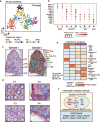Single-cell spatial transcriptomic analysis reveals common and divergent features of developing postnatal granule cerebellar cells and medulloblastoma
- PMID: 34210306
- PMCID: PMC8247169
- DOI: 10.1186/s12915-021-01071-8
Single-cell spatial transcriptomic analysis reveals common and divergent features of developing postnatal granule cerebellar cells and medulloblastoma
Abstract
Background: Cerebellar neurogenesis involves the generation of large numbers of cerebellar granule neurons (GNs) throughout development of the cerebellum, a process that involves tight regulation of proliferation and differentiation of granule neuron progenitors (GNPs). A number of transcriptional regulators, including Math1, and the signaling molecules Wnt and Shh have been shown to have important roles in GNP proliferation and differentiation, and deregulation of granule cell development has been reported to be associated with the pathogenesis of medulloblastoma. While the progenitor/differentiation states of cerebellar granule cells have been broadly investigated, a more detailed association between developmental differentiation programs and spatial gene expression patterns, and how these lead to differential generation of distinct types of medulloblastoma remains poorly understood. Here, we provide a comparative single-cell spatial transcriptomics analysis to better understand the similarities and differences between developing granule and medulloblastoma cells.
Results: To acquire an enhanced understanding of the precise cellular states of developing cerebellar granule cells, we performed single-cell RNA sequencing of 24,919 murine cerebellar cells from granule neuron-specific reporter mice (Math1-GFP; Dcx-DsRed mice). Our single-cell analysis revealed that there are four major states of developing cerebellar granule cells, including two subsets of granule progenitors and two subsets of differentiating/differentiated granule neurons. Further spatial transcriptomics technology enabled visualization of their spatial locations in cerebellum. In addition, we performed single-cell RNA sequencing of 18,372 cells from Patched+/- mutant mice and found that the transformed granule cells in medulloblastoma closely resembled developing granule neurons of varying differentiation states. However, transformed granule neuron progenitors in medulloblastoma exhibit noticeably less tendency to differentiate compared with cells in normal development.
Conclusion: In sum, our study revealed the cellular and spatial organization of the detailed states of cerebellar granule cells and provided direct evidence for the similarities and discrepancies between normal cerebellar development and tumorigenesis.
Keywords: Cerebellum; Development of granule cells; Differentiated granule neurons; Granule neuron progenitors; SHH medulloblastoma; Single-cell RNA sequencing; Spatial transcriptomics.
Conflict of interest statement
All authors read and approved the final manuscript. The authors declare that they have no conflict of interest.
Figures








Similar articles
-
RBP-J is not required for granule neuron progenitor development and medulloblastoma initiated by Hedgehog pathway activation in the external germinal layer.Neural Dev. 2010 Oct 15;5:27. doi: 10.1186/1749-8104-5-27. Neural Dev. 2010. PMID: 20950430 Free PMC article.
-
Stox1 as a novel transcriptional suppressor of Math1 during cerebellar granule neurogenesis and medulloblastoma formation.Cell Death Differ. 2016 Dec;23(12):2042-2053. doi: 10.1038/cdd.2016.85. Epub 2016 Aug 26. Cell Death Differ. 2016. PMID: 27564589 Free PMC article.
-
Hedgehog pathway permissive conditions allow generation of immortal cell lines from granule cells derived from cancerous and non-cancerous cerebellum.Open Biol. 2019 Jan 31;9(1):180145. doi: 10.1098/rsob.180145. Open Biol. 2019. Retraction in: Open Biol. 2020 Jun;10(6):200136. doi: 10.1098/rsob.200136. PMID: 30958113 Free PMC article. Retracted.
-
Modeling medulloblastoma with genetically engineered mice.Neurosurg Focus. 2005 Nov 15;19(5):E7. doi: 10.3171/foc.2005.19.5.8. Neurosurg Focus. 2005. PMID: 16398471 Review.
-
Recent advances in SHH medulloblastoma progression: tumor suppressor mechanisms and the tumor microenvironment.F1000Res. 2019 Oct 29;8:F1000 Faculty Rev-1823. doi: 10.12688/f1000research.20013.1. eCollection 2019. F1000Res. 2019. PMID: 31700613 Free PMC article. Review.
Cited by
-
The Tumor Microenvironment of Medulloblastoma: An Intricate Multicellular Network with Therapeutic Potential.Cancers (Basel). 2022 Oct 13;14(20):5009. doi: 10.3390/cancers14205009. Cancers (Basel). 2022. PMID: 36291792 Free PMC article. Review.
-
Medulloblastoma Spatial Transcriptomics Reveals Tumor Microenvironment Heterogeneity with High-Density Progenitor Cell Regions Correlating with High-Risk Disease.bioRxiv [Preprint]. 2024 Jun 28:2024.06.25.600684. doi: 10.1101/2024.06.25.600684. bioRxiv. 2024. PMID: 38979174 Free PMC article. Preprint.
-
The Molecular Basis of Pediatric Brain Tumors: A Review with Clinical Implications.Cancers (Basel). 2025 May 4;17(9):1566. doi: 10.3390/cancers17091566. Cancers (Basel). 2025. PMID: 40361492 Free PMC article. Review.
-
Spall: accurate and robust unveiling cellular landscapes from spatially resolved transcriptomics data using a decomposition network.BMC Bioinformatics. 2024 Dec 18;25(1):379. doi: 10.1186/s12859-024-06003-1. BMC Bioinformatics. 2024. PMID: 39695962 Free PMC article.
-
Liquid biopsy for monitoring medulloblastoma.Extracell Vesicles Circ Nucl Acids. 2022 Sep 28;3(3):280-291. doi: 10.20517/evcna.2022.36. eCollection 2022. Extracell Vesicles Circ Nucl Acids. 2022. PMID: 39697492 Free PMC article. Review.
References
Publication types
MeSH terms
Substances
LinkOut - more resources
Full Text Sources
Molecular Biology Databases

